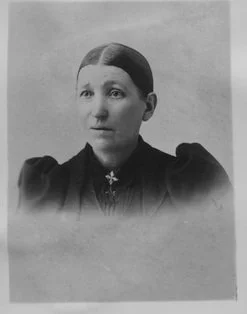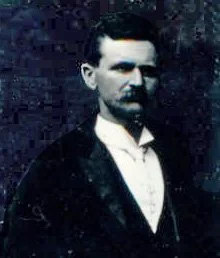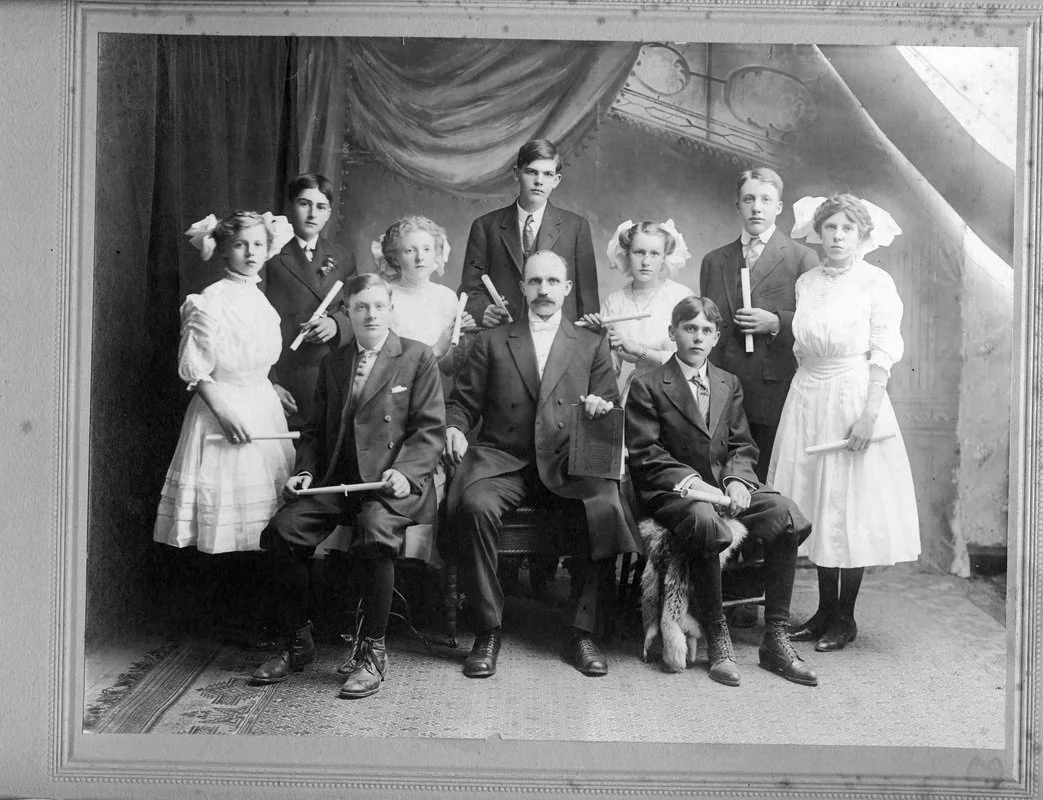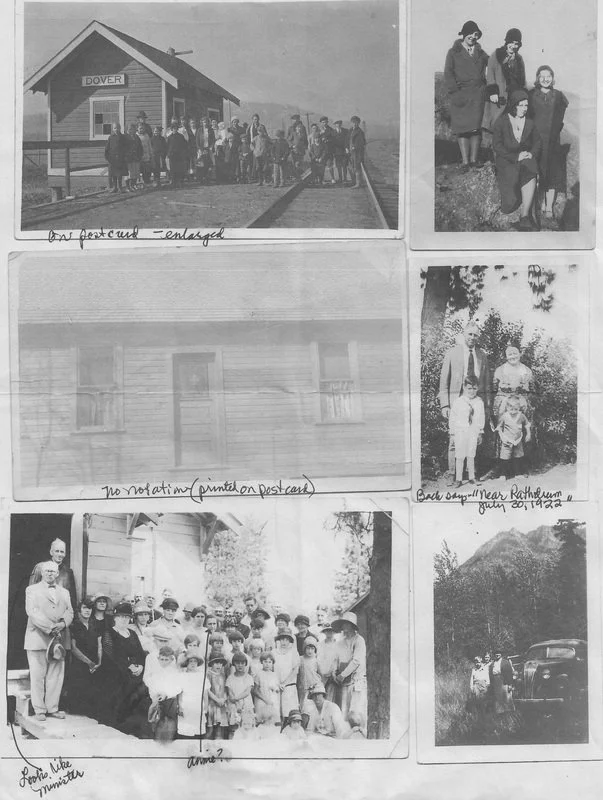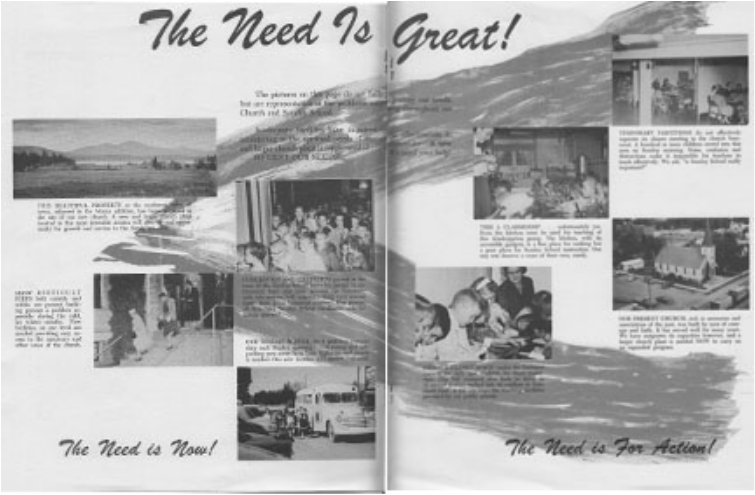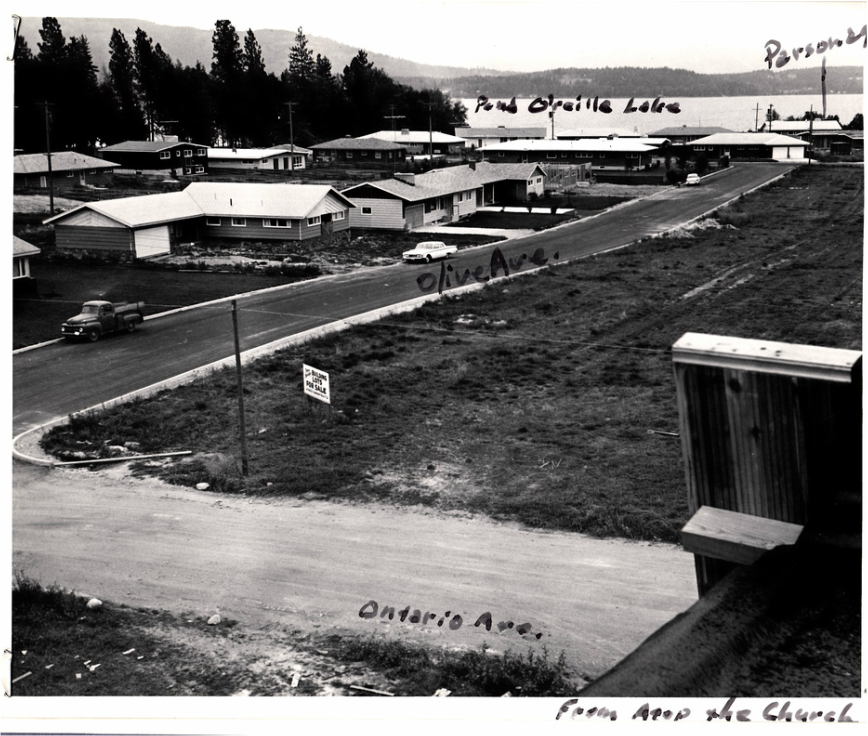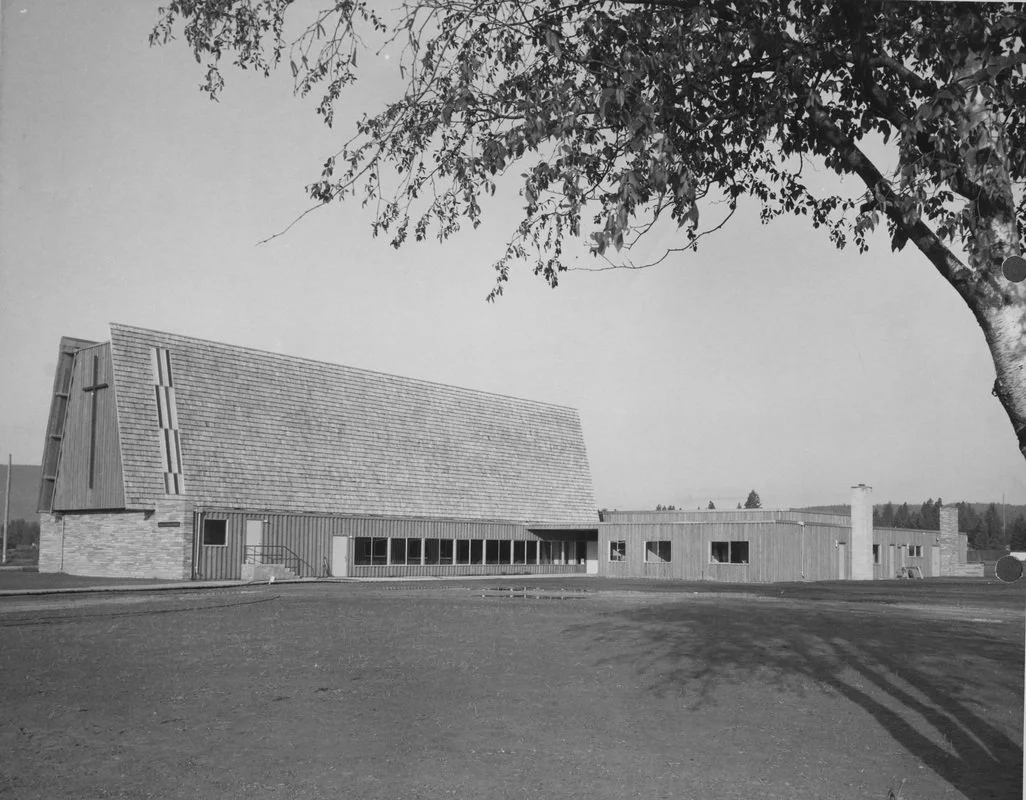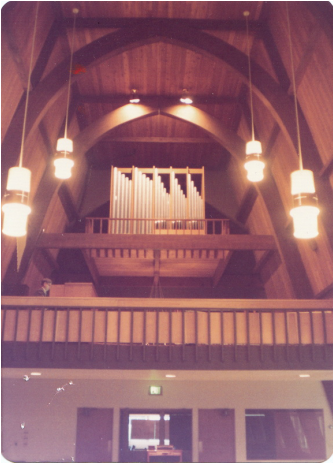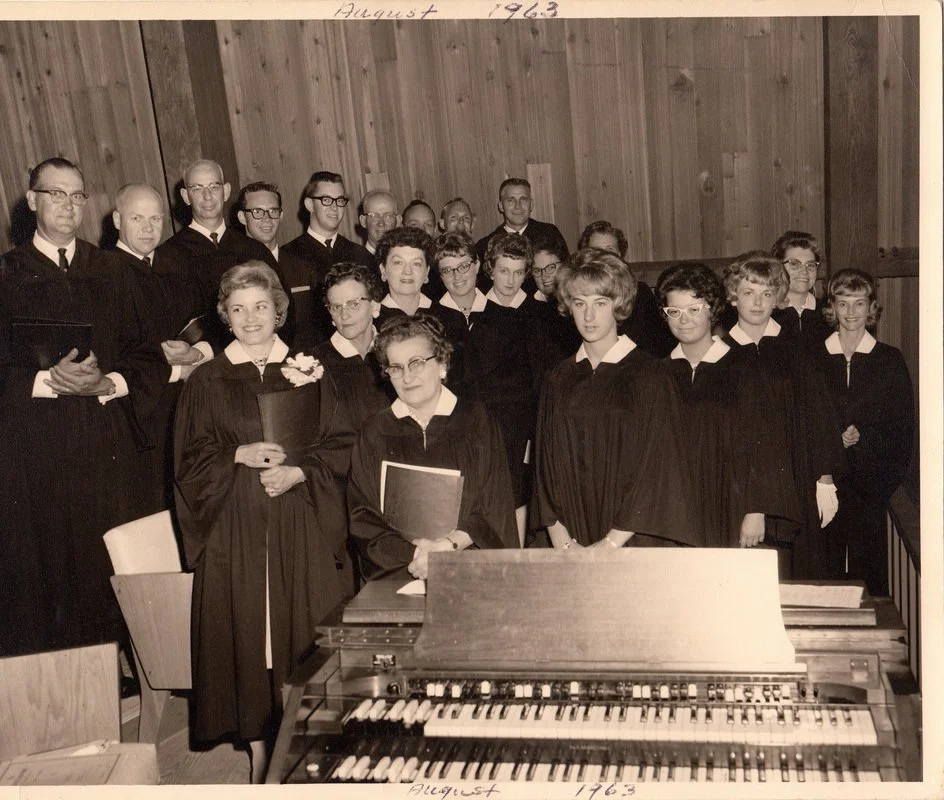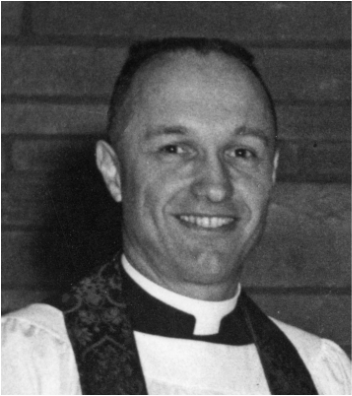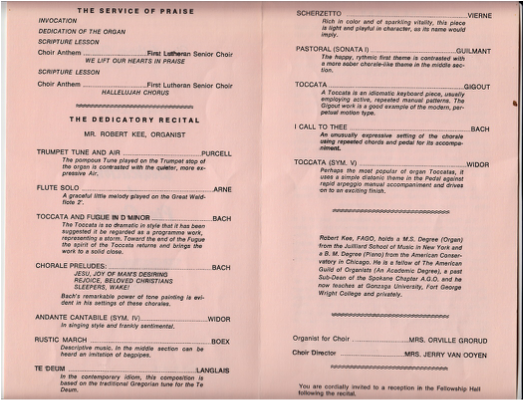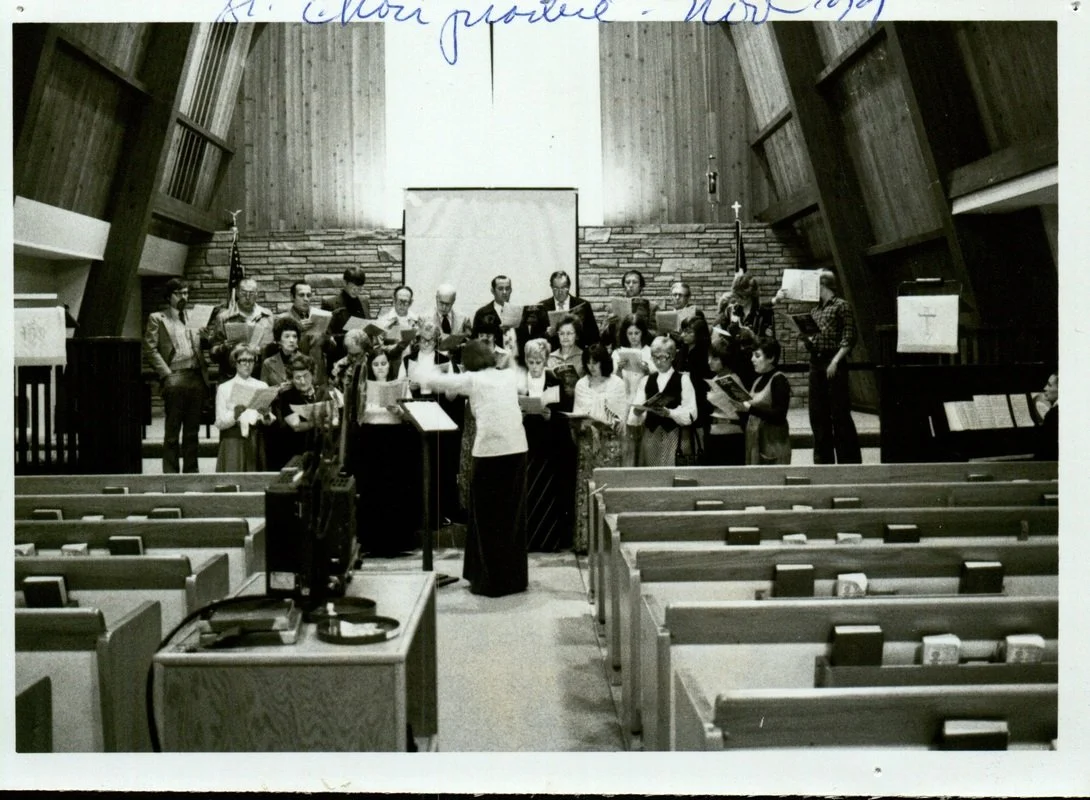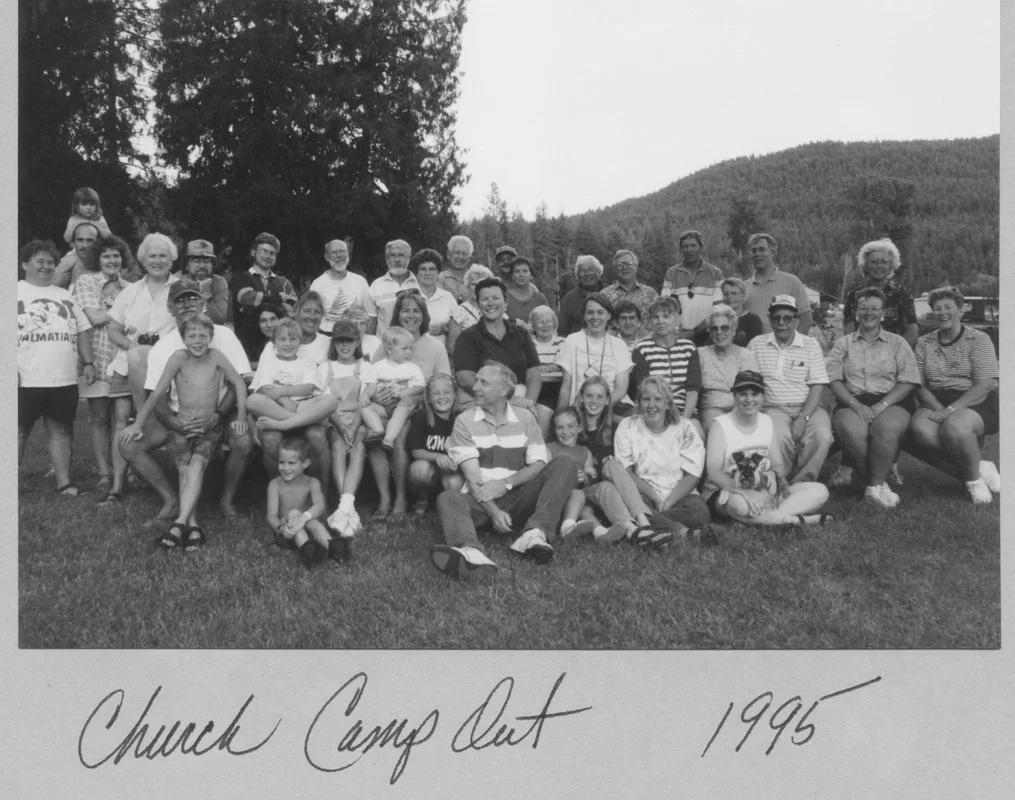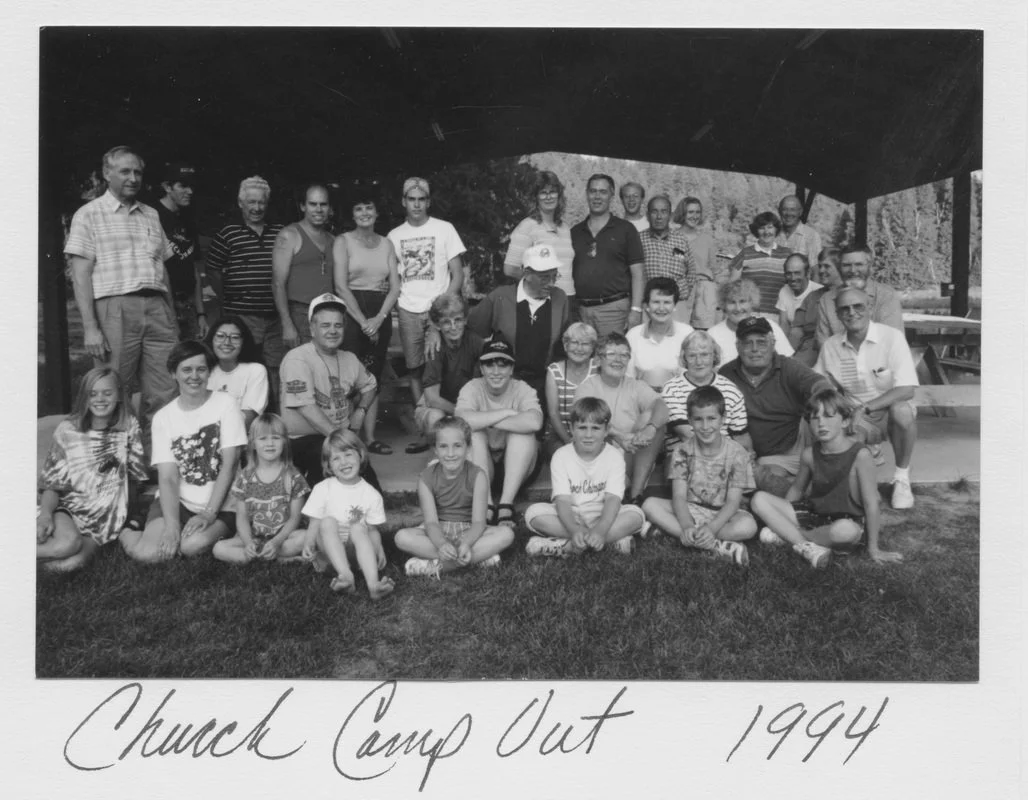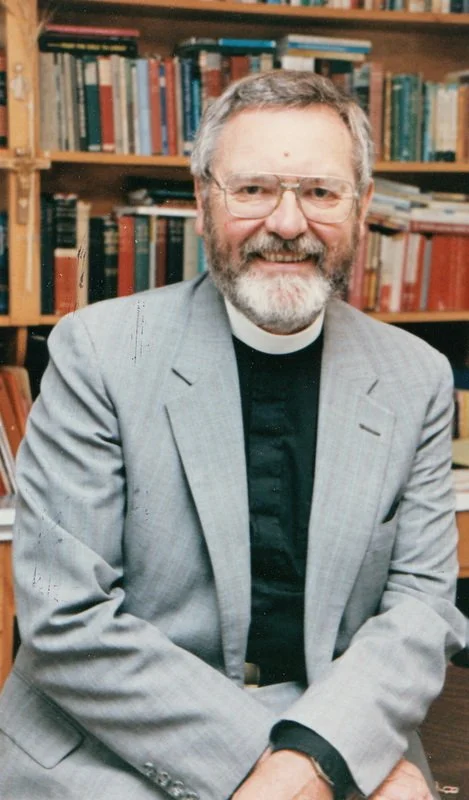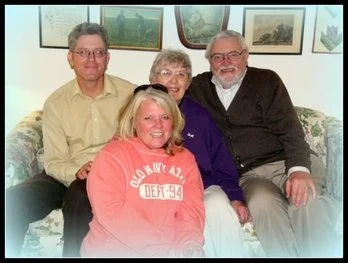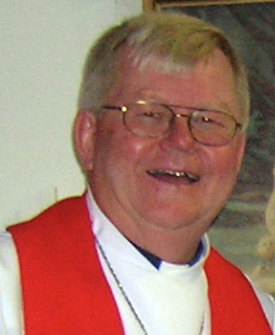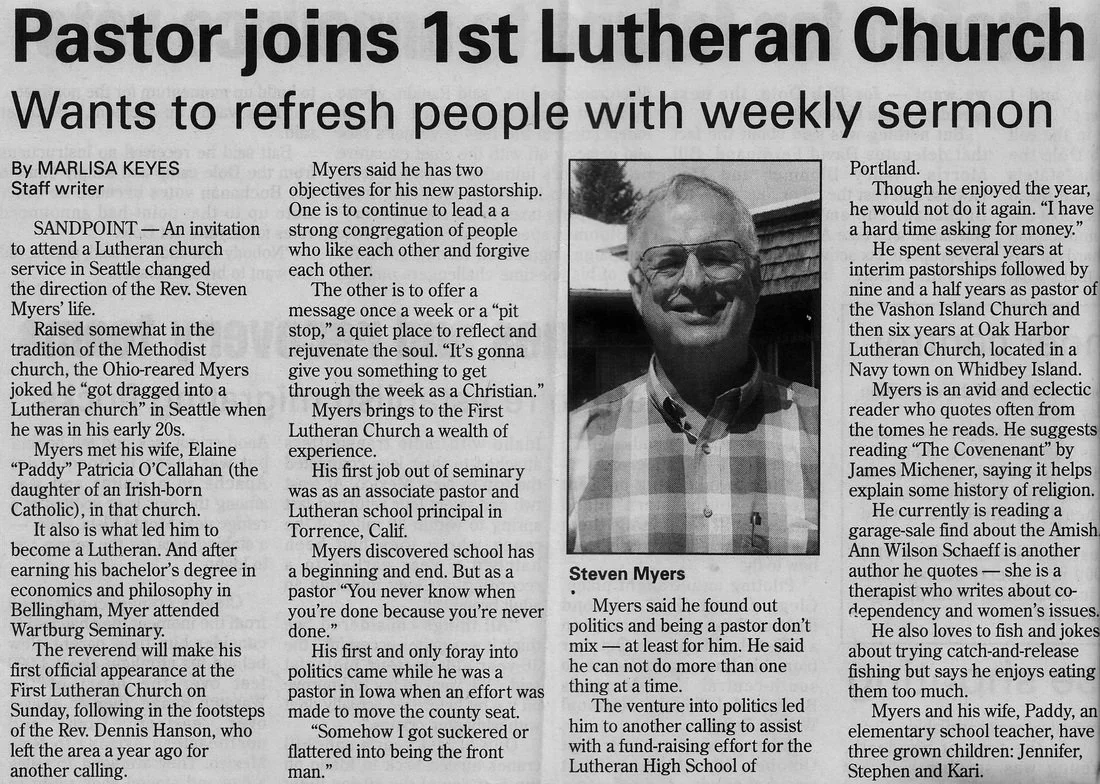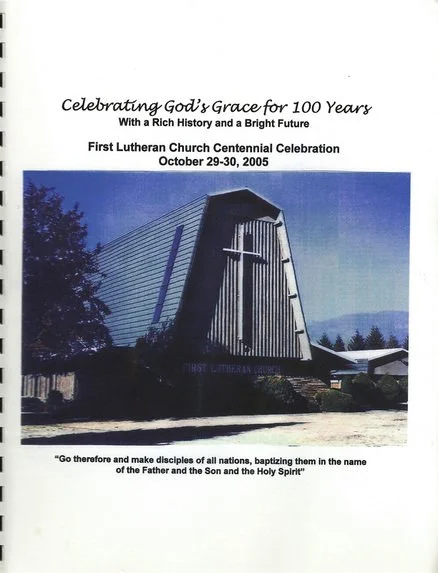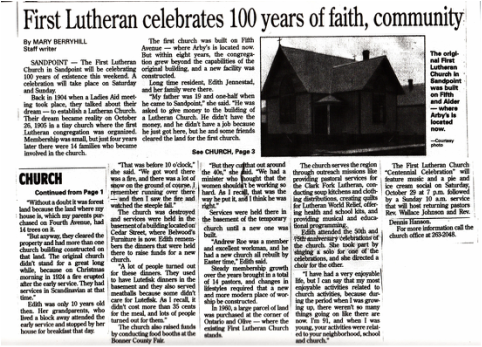Historic Events of First Lutheran Church
Our Beginnings
The year was 1904. Teddy Roosevelt was president. It was the age of silent films, and aviation was just becoming part of our lexicon. Idaho was almost 15 years old as a state. Sandpoint was only 3 years old as a city, having been incorporated in 1901. Idaho became the nation's 43rd state in 1890, population of 88,000.
In 1900, Scandinavians constituted approximately one-fourth of the total foreign-born in Idaho. Norwegian Lutherans started Spokane College, located on 29th Avenue in Spokane, and it was from that teaching staff that we received most of our itinerant pastors who visited us during our planning and building stages.
Painting by Dar Cogswell depicting our 2nd church.
The Ladies’ Aide Society Starts it All
Four women met first to organize a Sunday School and a Ladies Aide Society in 1904, long before we had a building in which to worship. These women felt that religious education was highly valued and needed, and getting qualified teachers was their first chore.
One of those teachers hired in 1904 was the aunt of our very own Dagmar Kirking. Her name was Louise Haughness. Her sister’s name was Tillie Thomason, and they worked together building up the Sunday School and choir. This eventually led to planning, organizing, and building First Lutheran Church in Sandpoint.
These women and two others invited Reverend Olaf Glasoe to meet them at the home of Anna Johnson and discuss how to get a church organized. Glasoe was Superintendent of Missions for the United Norwegian Lutheran Church in America. He travelled from Spokane to be with the ladies at this first meeting. He gave a short devotional talk and helped them with planning. The first step, he said, was to form a Ladies’ Aide Society.
Louise Haughness, one of our first Sunday School teachers, an aunt of Dagmar Kirking.
Mrs. Thomas Thomason, sister to Louise, also taught Sunday School and directed choir.
A Hand-Written Constitution is Drawn Up.
On October 6, 1905, a meeting was held at Peter Anderson’s home, with Reverend Olaf Glasoe present again, and a hand-written constitution was drawn up. Reverend Glasoe taught at Spokane College and traveled to Sandpoint once or more each month to conduct services and teach Sunday School in various homes and buildings in the community. When he couldn’t come, Reverend Thormosgaard and Reverend Thompson came. German-speaking ministers often came and preached in the afternoon on Sundays.
Reverend Glasoe started many mission churches in Washington and Idaho in the early part of the 1900’s.
Reverend Olaf Glasoe when he was on the faculty at St. Olaf’s College.
From Norwegian Beginnings, the Community Grows.
In the 20’s and 30’s and 40’s, on All Saints Day you would have heard these names called out as the church bell pealed once for each: Anderson, Thomason, Halverson, Field, Larson, Solberg, Sund, Haughness, Iverson, Johnson, Olson. Many of their descendants still live in this area, and some are still members of this church. Meetings and sermons were in Norwegian.
Church services and Sunday School classes were often held in the Humbird Mill Schoolhouse, or in a member’s home until the building was completed at 5th and Alder. Mr. Kolstad agreed to build the church for $325. By the time it was finished, it cost about $1000.
In September of 1909, we got our first resident pastor, Reverend Skindlov. 14 families supported the church that year.
In October 1909 the parsonage was started. It was ready for the Pastor’s family to move in on Dec 21st of 1909. It cost $800 at the start, but was $902.90 by the time it was complete. Andrew Roe built the parsonage.
Confirmation Class, 1910, with Reverend Skindlov in center
First resident pastor, Rev A.M. Skindlov
First Confirmation Class
This is one of only a few known pictures of the first building.
Our 2nd Church Building
Our 2nd Church is dedicated in April of 1918.
The second church, pictured above, was dedicated in April of 1918. The parsonage sits right next to the church.
On Christmas Day in 1924, a fire damaged the church considerably, but it was repaired and used again.
This 2nd building still stands, though in a new location north of Bonners Ferry, and with a new name, a Methodist Church. The building was sold to them in 1961, and they took it apart and reassembled it in the new location.
Christmas Day Fire
The Interior of the 2nd Church is a Beloved Backdrop.
Many of the wedding pictures and older confirmation class pictures hanging on our History Wall show this altar in the background. It was visually stunning. The altar painting is now in use in our present-day chapel.
Unification With the German Lutherans
It is thought that there were a large number of German-speaking Lutherans who attended the Norwegian Church. Plans were put in motion by Rev. Skindlov to meet their needs by inviting German-speaking pastors on a monthly basis to come to Sandpoint and provide services in German in the afternoon. They got a full-time pastor and built their own church in 1912. It was named Trinity Evangelical German Lutheran. The building still stands today, but has been refurbished to be a house and not a chapel.
Congregations
From notes left by Reverend Swinehart:
"Three lots 75 x 150' were purchased at Main and Alder Streets, and a chapel was erected by Pastor and members, hand in hand.
”The actual building, with several articles of furniture, were procured at a cash outlay of only $613.53.
”In the matter of labor, Mr. Robert Altman took the lead, being assisted day after day by the pastor of the church. The latter in turn enjoyed the hospitality of the various families of the congregation.
Mr. John Loeffler wired the building free of charge, donating both labor and materials.
”Mr. Fred Holz and Mr. LV Sammons donated several days work. Mr. George Funk donated a large load of sand and gravel. Others who helped with the cement work, the chimney, the roof, and the carpenter work in general where the following: William Weisleman, Otto Mosolf, John Burt, Fred Stulz and son, Anton Petri, Hugo Krause, John Loeffler, HF Killian, Irwin Altman, and Walter Swineherd. The willing help of the ladies of the congregation, in addition to their financial contributions, as individuals and through the Aid Society, were appreciated. They put the blue cardboard plaster on the walls and ceilings and they decorated the windows with stained-glass paper. They also assisted in varnishing the pews and lectern. They oiled the floor, and one of them even helped to paint the exterior of the building!
”But above all, the congregation is indebted to Mr. Robert Altman for constant assistance and encouragement. The Lord has been gracious to us let us show our appreciation by coming to him.
”Rev. Swinehart."
This is a letter that Reverend Gabrielson printed welcoming the German Church members when financial constraints made it necessary for them to merge with the Norwegian Church during the Depression. Also Pastor Swinehart was aging and ill, which added to their burden.
September 18, 1938
After the morning service at Emmanuel Norwegian Lutheran Church, a meeting was held with a number of members of Trinity German Lutheran Church. Present were Robert Altman and Mrs. Robert Altman, a nonmember. Mrs. Crabtree, Mrs. Krause, Mrs. Petrie, Mrs. R. Prepkorn and Mrs. F. Holtz.By request, Rev. G. Gabrielson was also present.
Rev. Swinehart read three resolutions made by the church members concerning the church structure and the contents of the church, and they passed unanimously. In short, the trustees were to sell the property, to reserve the furniture for possible use in another mission church, and to turn over the proceeds of sale of the church building to the Norwegian Lutheran Church, which Reverend Swineherd encouraged his members to join.
Rev. Gabrielson made it very clear that the Trinity members were very welcome without any financial considerations at all.
The collage, recently recovered, was from Mae and Walt Burt. The middle row shows the main door of the German Church, and the bottom row shows Reverend Swinehart standing behind a parishioner with most of the congregation assembled outside. Walt Burt can identify members of his family in that picture. The pastor and his family stand next to their car in the other picture, and outside their home in Rathdrum, in the family grouping above that one.
This booklet from 1965 shows all three churches.
Reverend Hagen served as Pastor when we celebrated our 25th anniversary.
Growing Pains
The first structure served us well until 1917, while Reverend Otterstad was Pastor. It was decided that the church building no longer met the needs of our growing membership, and pledges were started for a new building. That resulted in the 2nd church structure, built in 1917-1918, and which by 1926 had been damaged by fire but repaired for worship again. In the 1930’s, the Great Depression took hold.
On 29 October 1929, known as Black Tuesday, the New York stock market crashed, ruining millions of investors. These were difficult years of a failing economy. People stopped buying unnecessary goods, and many businesses failed. The impact was severe in the West. Unemployment reached nearly 33% in some western states.
Many families had to swallow their pride and wait in long lines for handouts of bread or other foods. Some lost their farms when they could not meet mortgage payments. Churches tried to help out when they could with soup kitchens and clothing, but the church income from tithes and weekly offerings also suffered. Our church often could not pay Reverend Hagen his salary, even with the Ladies’ Aide financial help.
Pastor Hagen had a family of 6 to support, and eventually had to take work elsewhere where the economy was in better shape than here in North Idaho.
When Reverend Hagen left, it was decided that we merge with the Bonners Ferry Lutheran Church, and share their Pastor. Reverend Gabrielson moved down to our parsonage, and served us and two other churches from 1933-1940.
Both Pastor and Mrs. Gabrielson were talented musicians, and formed choirs in all the churches they served. The church grew substantially, especially when the war ended. It was right after Reverend Gabrielsson arrived that the German Lutheran Church had to close, and he welcomed them warmly into the Norwegian Congregation. The next section shows a bulletin that highlights the hectic schedule for this one pastor who had several churches for so long.
We had a huge celebration on our 25th birthday.
Reverend Gabrielson
Building Again
Building efforts ensued, including the 1961 Ground Breaking, and the addition of an educational wing in 1969, completing our building program.
The table in the picture at right is located at the place where the altar stands today.
As pictured (left to right): Marv Kirking, Bob Olson (secretary), Clarence Stilwell (Bd of Ed Chairman), Mae Burt (Pres. of Women’s Missionary Soc.), Severe Ericsson(Treasurer), Paul Hart (Deacon), Aleatha Sawhill (Fin. Secy)Forrest Ballou (trustee), Earl Thomas (deacon), Bill Hart (trustee), George Leitze(Gen. Contractor), Arnold Piehl (trustee), Norm Bauer( VP), Joe Venishnick(Bldg Comm), LeRoy Hedlund (Bldg Comm. Chairman), Louis Oestmann (Pres. of Cong.), Dr. Rev. Skindlov (first resident pastor), Rev. Wallace Johnson, Pastor.
From a booklet to raise awareness and funds for a new church, with photos showing the crowded Sunday School rooms. It was said that curtains were used as dividers and several Sunday School classes met in the same large basement room.
Rev. A.W. Johnson was instrumental in planning and implementing the 3rd and final church building. It still looks as beautiful, or even more so, then it did in those early days of the 1960’s.
Construction & Dedication
In August of 1957, seven acres of land was purchased at Olive and Ontario Streets at the cost of $11,400.
In February of 1960, the congregation voted to build a parsonage at the cost of $23,200. It was completed in June of 1960.
The first service held in the new church was Christmas Eve of 1960. The dedication took place 6 months later in June of 1961. The background picture behind the title on this page shows the number of area Pastors who attended and participated in that dedication service
View Construction Images below.
This page of mini-photos was found in the Ladies Aide Book.
Ministry During a Time of Change
1950-1960s
Reverend D.W. Taylor served from 1963- 1969, those turbulent years of national unrest with three assassinations in our country.
Christian response to the revolutionary changes of the sixties is still evident. Some researchers say that contemporary music and a more relaxed, casual approach toward church are its major contributions. It was a turbulent and troubling time, causing many Americans to confront issues such as race, gender, sexuality, war, authority, and patriotism.
Pastor Taylor was with us for most of this period. The Sunday School wing and chapel were built and dedicated during his stay. Reverend Grorud served from 1969-76. While he was with us, the pipe organ was built and dedicated.
1963 Senior Choir
1977 Junior Choir
Reverend D.W. Taylor
Reverend Grorud
1999 Senior Choir
75th Anniversary Booket, inside pages
The family of Refugees from Cambodia that First Lutheran sponsored,teaching them English, and offering physical and spiritual support and guidance.
Family campouts were started which made the church family even more closely knit.
New Growth in the 1980s
75th Anniversary
Pastor Dennis Hanson came in 1976 and served longest of any pastor, till 1995. During his tenure, we paid off the parsonage and the church grew in number enough to warrant calling an assistant pastor, Larry Cudmore.
Pastor Cudmore served as assistant to Pastor Hanson, preaching, teaching classes, and serving the Clark Fork Church which 1st Lutheran helped support as a mission for a number of years until the mid 90’s.
The church sponsored a refugee family during these years, and another set of pipes were added to the organ. The chimes were also added during Hanson’s tenure. The church offered a clothing room and served meals for those in need in the community.
Pastor Dennis Hanson
Pastor Dennis Hanson and his family.
Rev. Oines was the Interim pastor from 1995-1996
Pastor Cudmore
Pastor Cudmore as he looked when he returned to Clark Fork Lutheran for their 50th anniversary in 2005 when Rev. Robert Nale was still there.
Pastor Steven Myers is selected in 1997. Pastor Steve Myers is remembered as a “folksy, down-to-earth” person who loved to laugh and did it a lot. He was known as a “people person” who seemed to make those around him feel at ease.
A New Millennium
Reverend Olson served First Lutheran from 1999-2013. During his tenure, the 100th Anniversary was celebrated..
Also, the church decided on a huge mission project, a senior living community, Luther Park. Pastor Olson worked overtime planning and overseeing Luther Park, and Pastor Steve Neuder was called as assistant.
Pastor Olson’s period of ministry was from 1999-2012, the second longest of all our pastors. Pastor Chenault became our interim and guided us ably in finding a new shepherd.
So many volunteers stepped up and helped the church family through the interim years. Strengths became evident that weren’t evident before. After two years of searching and praying and meeting and praying, the church family found Pastor Lori Morton.
Today, Pastor Duane Fister is leading First Lutheran Church into the future.
Pastor Chenault
Pastor Dave Olson
Pastor Steve Neuder
Pastors Hanson, Olson, and Johnson at the 100th Anniversary Celebration
One of the special Sunday services of celebration of the 100th anniversary.
Luther Park at its conception.
Luther Park Ribbon Cutting Ceremony.



